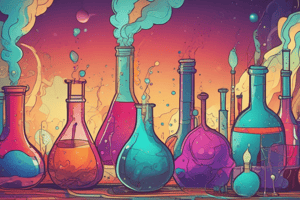Podcast
Questions and Answers
What is the atomic number of the element whose atoms bond to each other in chains, rings, and networks?
What is the atomic number of the element whose atoms bond to each other in chains, rings, and networks?
6
How many pairs of electrons are shared between two adjacent carbon atoms in a saturated hydrocarbon?
How many pairs of electrons are shared between two adjacent carbon atoms in a saturated hydrocarbon?
1
In a redox reaction, which particles are lost and gained in equal numbers?
In a redox reaction, which particles are lost and gained in equal numbers?
electrons
What is the oxidation state for an Mn atom?
What is the oxidation state for an Mn atom?
According to one acid-base theory, a water molecule acts as a base when it accepts?
According to one acid-base theory, a water molecule acts as a base when it accepts?
The acidity or alkalinity of an unknown aqueous solution is indicated by its?
The acidity or alkalinity of an unknown aqueous solution is indicated by its?
The laboratory process in which the volume of a solution of known concentration is used to determine the concentration of another's solution is called?
The laboratory process in which the volume of a solution of known concentration is used to determine the concentration of another's solution is called?
What type of change is represented by the process of fission?
What type of change is represented by the process of fission?
Which element has atoms that can bond with each other to form ring, chain, and network structures?
Which element has atoms that can bond with each other to form ring, chain, and network structures?
What is the number of electrons shared in the multiple carbon-carbon bond in one molecule of 1-pentyne?
What is the number of electrons shared in the multiple carbon-carbon bond in one molecule of 1-pentyne?
Butanol, butanone, and diethylether have different properties because the molecules of each compound differ in their?
Butanol, butanone, and diethylether have different properties because the molecules of each compound differ in their?
What occurs when a magnesium atom becomes a magnesium ion?
What occurs when a magnesium atom becomes a magnesium ion?
One acid-base theory defines an acid as an?
One acid-base theory defines an acid as an?
Which phrase describes the decay modes and half-lives of K-37 and K-42?
Which phrase describes the decay modes and half-lives of K-37 and K-42?
Which particle has a mass that is approximately equal to the mass of a proton?
Which particle has a mass that is approximately equal to the mass of a proton?
Which change occurs during a nuclear fission reaction?
Which change occurs during a nuclear fission reaction?
In which 1.0-gram sample are the particles arranged in a crystal structure?
In which 1.0-gram sample are the particles arranged in a crystal structure?
When a reversible reaction is at equilibrium, the concentration of products and reactants must be?
When a reversible reaction is at equilibrium, the concentration of products and reactants must be?
In chemical reactions, the difference between the potential energy of the products and the potential energy of the reactants is equal to the?
In chemical reactions, the difference between the potential energy of the products and the potential energy of the reactants is equal to the?
What is the name of the compound with the formula CH₃CH₂CH₂NH₂?
What is the name of the compound with the formula CH₃CH₂CH₂NH₂?
Which compound is an isomer of C₂H₅OC₂H₅?
Which compound is an isomer of C₂H₅OC₂H₅?
Ethanoic acid and 1-butanol can react to produce water and a compound classified as an?
Ethanoic acid and 1-butanol can react to produce water and a compound classified as an?
During an oxidation-reduction reaction, the number of electrons gained is?
During an oxidation-reduction reaction, the number of electrons gained is?
Flashcards are hidden until you start studying
Study Notes
Chemical Reactions and Energy
- Energy is absorbed during bond breaking and released during bond formation in chemical reactions like O₂ → O + O.
- The heat of reaction (∆H) is the difference in potential energy between reactants and products in a chemical reaction.
Entropy and Energy Changes
- Natural systems favor changes that lead to higher entropy (disorder) and lower energy states.
- In equilibrium, concentrations of reactants and products remain constant, indicating the rates of forward and reverse reactions are equal.
Atomic Structure and Bonding
- Carbon (atomic number 6) forms chains, rings, and networks due to its bonding capabilities.
- In saturated hydrocarbons, adjacent carbon atoms share one pair of electrons, forming single covalent bonds.
Redox Reactions
- In redox reactions, electrons are lost by the oxidized substance and gained by the reduced substance in equal numbers.
- The oxidation state of uncombined atoms is zero, while atoms lose electrons to increase their oxidation state when forming ions.
Acids and Bases
- An Arrhenius acid produces H⁺ ions in solution, while an Arrhenius base produces OH⁻ ions.
- According to the Bronsted-Lowry theory, an acid donates protons, and a base accepts protons.
Electrolytes
- Electrolytes conduct electricity when dissolved in water and include ionic compounds, acids, and bases.
- Compounds like KNO₃ and H₂SO₄ are classified as electrolytes because they dissociate in solution.
Nuclear Chemistry
- Potassium has isotopes (e.g., K-37 and K-42) with different decay modes and half-lives, where some isotopes are stable and others are not.
- Nuclear fission involves splitting an atomic nucleus, converting matter into energy.
Titration and pH
- Titration is used to determine the concentration of a solution by reacting it with a solution of known concentration.
- pH indicates the acidity or alkalinity of a solution, with a scale where values less than 7 are acidic, and greater than 7 are basic.
Isomers and Functional Groups
- Compounds like butanol and butanone differ in properties due to their functional groups, impacting their reactivity.
- CH₃CH₂CH₂NH₂ is identified as 1-propanamine, an organic compound defined by its functional group.
Chemical Changes and Reactions
- During chemical changes, including electrolysis, energy is required, especially for non-spontaneous reactions.
- Reacting an Arrhenius acid with an Arrhenius base produces water and a salt, resulting in neutralization.
Structural Properties of Compounds
- Compounds like C₂H₅OC₂H₅ can have isomers, differing in structure but retaining the same molecular formula.
- The presence of different functional groups in organic molecules contributes to their varied physical and chemical properties.
Studying That Suits You
Use AI to generate personalized quizzes and flashcards to suit your learning preferences.




